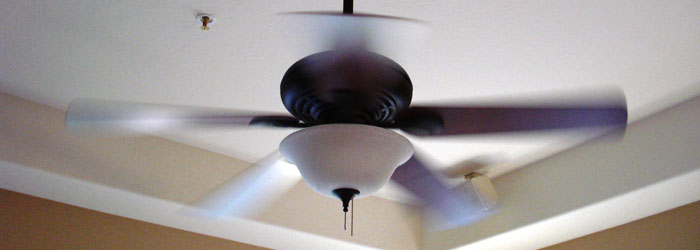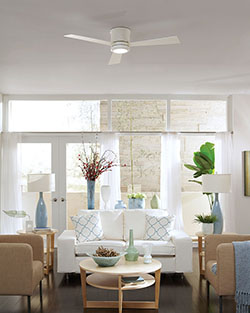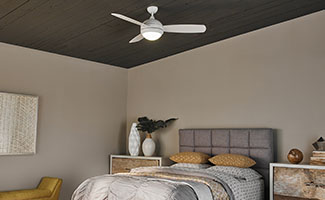Can You Cool Your House With Fans?
 05 July 2017
05 July 2017 

What Fans Can or Cannot Do in Your House
It's the time of year when you generally depend on an air conditioner for cooling, but you may be wondering what fans can also do for your comfort level. Here are seven things to remember:
1 | Do install overhead fans in your house
 When you're in a room, a ceiling fan can definitely make you feel cooler without running the air conditioner on full blast. Some experts say people set thermostats four degrees higher when a fan is running. Interior decorators might tell you that circulating fans will destroy the décor in your room, but they're a necessity in the Arizona desert and there are many new sleek designs on the market. The American Lighting Association recommends hanging the fan at least 7 feet above the floor; optimal placement would be 8 or 9 feet from the floor to provide better circulation and for aesthetic reasons.
When you're in a room, a ceiling fan can definitely make you feel cooler without running the air conditioner on full blast. Some experts say people set thermostats four degrees higher when a fan is running. Interior decorators might tell you that circulating fans will destroy the décor in your room, but they're a necessity in the Arizona desert and there are many new sleek designs on the market. The American Lighting Association recommends hanging the fan at least 7 feet above the floor; optimal placement would be 8 or 9 feet from the floor to provide better circulation and for aesthetic reasons.
2 | Do have an overhead fan in every bedroom
Installing fans is not a DIY project if you are wanting a fan on a ceiling where there was none before. There is a bit of electrical work that would require an electrician. If you just want to update to a new style of fan and replace an existing one, that can be a DIY project.
3 | Don't let ceiling fans run all the time when you're not home
A ceiling fan doesn't actually cool the air, and its motor generates heat and uses electricity. So, it's only beneficial to run it when someone is in the room. The old saying is: Fans cool people, but not rooms.
4 | Do install an exhaust fan in your kitchen
A kitchen exhaust fan will help to quickly remove heat and odors produced while cooking. If you're remodeling the kitchen, choose your exhaust fan and ventilation system carefully, particularly in Arizona. A range hood's performance is measured in cubic feet per minute or CFMs. The higher the CFM number, the more air the range hood can remove in a minute of operation.

The general recommendation for an electric range is 300 to 450 CFMs while a gas range will need 600 to 1,200. If you use a microwave with a built-in range hood, it might not have enough CFMs to pull the air and heat away. The noise of a ventilation hood can also deter you from running it, so find out what the hood sounds like before you install it.
5 | Don't hook up a fan to try to cool off your attic
The only thing an attic exhaust fan will do, whether it is solar- or electric-powered, is create negative pressure in the attic. That will cause the air-conditioned cool air inside your home to be drawn up into the attic. Ultimately, you will be increasing your demand for cool air downstairs. And if you use electricity to run the fan, you will be shocked at how much that fan running all the time can add to your bill. A homeowner told us that when he put a power ventilator in an attic on the gable end of his house to get rid of the hot air, his electric bill shot up $100 a month.
6 | Don't put an exhaust fan in your garage
Your garage is very hot in the summer, and when you drive your hot car into the garage, you raise the temperature. But if you install an exhaust fan, it would run constantly and raise your electric bill just as it would in your attic because it would start pulling cool air out of your house. The only option for cooling off your garage would be insulating the walls and the garage door and installing an evaporative cooler or mini-split air conditioner, and that can be costly as well.
7 | Run the fan in your HVAC system
Even when your AC is not running to cool the house, you can run the fan in your HVAC system to circulate and clean the air in your house – except in times of high humidity. But don't keep that fan running all the time night and day when you're on vacation or out of the house. It costs money to run the fan constantly, after all. Running the fan by itself during the monsoon season could greatly increase the humidity in your house.
###
Photo Credits:
RELATED CONTENT:
- Blog: What Can I Do to Help My Air Conditioner Work More Efficiently?
- Blog: Five Ways to Fix Up Your Garage
- Blog: Do I Need To Ventilate My Attic, House And Roof?
- DIY FAQ: Reading and Understanding Your Utility Bill
- Podcast: Have You Tried Supercooling Yet?
Print this page
recent post
- Duck, Duck, Duct! How Often Should Ductwork Be Cleaned?
- Vinyl vs. Fiberglass Windows: Which Is The Better Choice Of Replacement Window?
- We May Be The Grand Canyon State, But The Rocky Mountains Are Important For Arizona
- Welcome to Arizona! Things A Newbie to Arizona Should Know
- The Pros & Cons of Buying A Flipped House
- Getting In On The Ground Floor
- Why It’s More Critical Than Ever To Get Your AC Serviced Before Summer
- The Reality of Remodeling
- What To Look For When Comparing Your Roofing Quotes
- What To Expect When Buying New Windows & Doors
